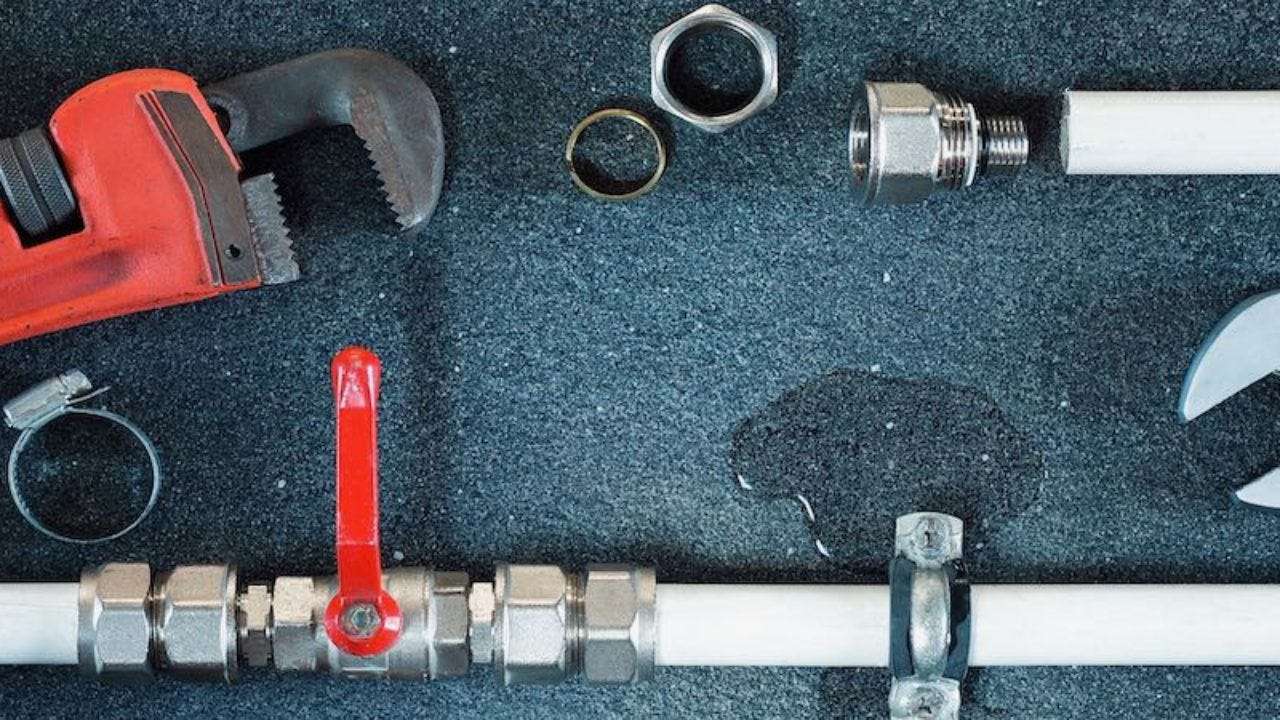Home Improvement
Common Emergency Plumbing Issues and How to Handle Them

Plumbing crises rarely occur when it’s handy. Whether your sink won’t drain or a burst pipe has flooded your house, these issues must be fixed.
You may save costs and avoid damage by knowing what a plumbing emergency is. This article will cover ten typical plumbing problems and efficient solutions.
Leaking Pipes
Leaking pipes aren’t just annoying; they can be expensive and damage your home’s water. Plus, they can cause mold and mildew, which are health hazards.
If you have a leaky pipe, it’s important to turn off your water supply immediately and call a plumber. The plumber will be able to find the source of the leak and fix it before it gets worse.
Another common emergency plumbing is a clogged drain or toilet. The flushing of objects like paper towels, wipes, and hair that shouldn’t be in the toilet can be the source. In addition, a clogged toilet or drain may indicate a sewage backup, which poses a major health risk and must be addressed immediately.
It’s important to know the difference between a plumbing issue that needs fixing immediately and one that can wait until normal business hours. Knowing these differences can save you some stress and money in the long run.
Clogged Drains
One of the most common plumbing emergencies is a clogged drain or toilet. While this may not seem as serious as a burst pipe, it can still cause significant water damage and be frustrating.
If you discover that the water is draining slowly or not from your sinks, tubs, or showers, try using a plunger or chemical drain cleaner to see if it clears the obstruction. If these fixes are ineffective, immediately contact a plumber and cut off the water supply to the faulty fixture.
A clogged drain can also become a breeding ground for bacteria and other harmful organisms, so it’s important to address the issue immediately. By performing preventative maintenance like installing drain traps and cleaning your drains regularly, you can reduce the risk of a clog or other plumbing emergency.
Hot Water Leaks
A leaking hot water tank or pipes can quickly saturate your home with gallons of water, potentially causing extensive and expensive damage. To help prevent this, check and maintain your hot water system regularly and use low-flow showerheads and taps to limit water usage.
A blocked toilet is another frequent plumbing disaster that is readily preventable with routine maintenance and appropriate waste disposal methods. However, untreated blocked toilets can lead to severe raw sewage backups and structural damage to your home.
When dealing with a plumbing emergency, it is important to remain calm and take immediate action to mitigate the issue. Remember to shut off your water supply, open drains and fixtures, and assess the damage before calling an emergency plumber. With these simple steps, you can know that your plumbing problems will be resolved promptly and efficiently. For more information, contact a professional plumber today.
Broken Fixtures
Common plumbing emergencies involve broken fixtures like sinks, showerheads, toilets, and valves. Whether they are caused by age or wear and tear, these problems can lead to water damage and even structural issues in your home. Replacing these fixtures as soon as they start showing signs of wear can help prevent the need for emergency repairs down the road.
Another common plumbing emergency is a sewage line backup or leak. This very dangerous issue can cause significant flooding and property damage if left untreated. It is important to have your sewer lines regularly inspected and maintained to prevent these issues from occurring. You can also reduce your risk of a sewage line backup by properly insulating your pipes during the cold months and using proper waste disposal practices like avoiding flushing wipes, feminine hygiene products, or greasing down the drains.
In a plumbing emergency, the first thing to do is shut off your water supply. Find the water valve closest to the problem and turn it clockwise to stop the water flow.
Home Improvement
Heritage Event Venue Malaysia: Whitehouse @ The Estate on Federal Hill

In Malaysia’s vibrant event scene, finding a venue that seamlessly combines historical charm with modern amenities can be a challenge. Whether you are planning a corporate gathering, a wedding, or a private celebration, the right venue can make all the difference in creating a memorable and successful event. Whitehouse @ The Estate on Federal Hill stands out as one of Malaysia’s premier heritage event venues, offering a perfect blend of classic architecture, contemporary facilities, and unique spaces such as The Great Hall and a scenic Sky Balcony. Its distinctive character, versatility, and professional support make it an ideal choice for both corporate and personal events, from corporate event venue KL to wedding venues in Kuala Lumpur.
The Appeal of a Heritage Venue
Heritage venues offer a distinct ambiance that modern spaces often cannot replicate. Whitehouse @ The Estate is located in the historic Federal Hill area, boasting beautifully restored architecture, high ceilings, intricate woodwork, and elegant colonial detailing. This heritage charm provides a sophisticated backdrop that elevates any occasion, whether it is a professional conference or a social celebration.
Guests immediately notice the unique atmosphere, which combines history with elegance. The warm and inviting environment, complemented by features such as the garden view terrace, fosters meaningful interactions, enhances the aesthetic of events, and creates a lasting impression—key factors for any successful gathering.
Perfect for Corporate Events
For companies seeking a prestigious corporate event venue in KL, Whitehouse @ The Estate offers a combination of charm, practicality, and professional support. Its versatile spaces are suitable for a wide range of corporate functions, including meetings, seminars, workshops, product launches, and conferences.
Why Corporate Clients Choose Whitehouse @ The Estate:
- Flexible Spaces: Multiple halls and private rooms, including The Great Hall, can be adapted to the size and format of the event.
- Modern Technology: High-speed internet, audiovisual equipment, and climate-controlled rooms ensure smooth presentations and communication.
- Professional Staff: A dedicated team assists with planning, logistics, and on-site coordination, providing peace of mind for organizers.
The combination of heritage architecture and modern facilities ensures that corporate events at Whitehouse @ The Estate are both impressive and functional. Clients benefit from a setting that encourages creativity, engagement, and professional interaction while leaving a lasting impression on attendees.
Ideal for Weddings
In addition to corporate events, Whitehouse @ The Estate is a sought-after wedding venue Kuala Lumpur. Couples seeking a venue with character and elegance find it to be the perfect canvas for their dream wedding. Its timeless architecture, versatile halls, and charming outdoor areas like the Sky Balcony allow for both intimate ceremonies and grand celebrations.
Highlights for Wedding Hosts:
- Historic Ambiance: The heritage charm provides a romantic and elegant backdrop for photos and ceremonies.
- Customizable Layouts: Spaces can be adapted to accommodate guest lists of all sizes and seating arrangements.
- Full-Service Support: The venue’s team assists with décor, catering, and logistics, ensuring a stress-free planning process.
Couples appreciate how Whitehouse @ The Estate combines classic elegance with practical modern amenities, making it a reliable and stylish choice for hosting a truly unforgettable wedding.
Versatility for Every Occasion
One of the defining features of Whitehouse @ The Estate is its versatility. It is equally suitable for corporate gatherings, weddings, private parties, and social events. Its multiple halls, private rooms, and outdoor terraces can be configured for different themes, group sizes, and event formats, offering unparalleled flexibility.
- Corporate Functions: Board meetings, seminars, workshops, and networking events.
- Private Celebrations: Birthdays, anniversaries, and milestone parties.
- Weddings: Intimate ceremonies or lavish receptions.
This adaptability, combined with the venue’s heritage charm, makes Whitehouse @ The Estate one of the most sought-after heritage event venues in Malaysia, capable of hosting a wide range of events with elegance and sophistication.
Modern Facilities for a Seamless Experience
While celebrated for its heritage appeal, Whitehouse @ The Estate also provides all the modern amenities required for smooth event execution. Climate-controlled rooms, advanced audiovisual systems, high-speed internet, and catering facilities ensure every event runs seamlessly.
Whether it is a corporate presentation requiring professional technology or a wedding needing precise coordination of dining and entertainment, the venue’s modern facilities complement its classic charm perfectly. Guests experience both comfort and sophistication, enhancing the overall quality of the event.
Creating Lasting Memories
Whitehouse @ The Estate is not just a venue—it is a place where memories are created. Its historic architecture offers stunning backdrops for photography and video, while the thoughtfully designed spaces ensure that every guest feels comfortable and engaged.
For corporate events, this creates a professional yet inspiring atmosphere that strengthens connections and fosters collaboration. For weddings, it provides a romantic and elegant setting that couples and their guests will remember for years to come.
Why Whitehouse @ The Estate Stands Out
Several factors make Whitehouse @ The Estate a leading choice among heritage event venues in Malaysia:
- Heritage Architecture: Timeless design elements create an elegant and memorable ambiance.
- Versatile Spaces: Multiple halls, private rooms, and outdoor terraces accommodate a wide range of event types and sizes.
- Modern Amenities: Advanced technology, catering options, and climate-controlled spaces ensure smooth operations.
- Professional Team: Dedicated staff assist with planning, logistics, and execution, guaranteeing a seamless experience.
- Central Location: Conveniently located in Federal Hill, Kuala Lumpur, making it accessible for guests from across the city.
These features combine to provide a venue that delivers both prestige and practicality, appealing to businesses and couples alike.
Conclusion
Whether you are planning a corporate meeting, wedding, or private celebration, Whitehouse @ The Estate on Federal Hill exemplifies the perfect blend of heritage charm and modern functionality. As a premier corporate event venue in KL and wedding venue in Kuala Lumpur, it offers versatile spaces, professional support, and a unique atmosphere that elevates every event.
By choosing Whitehouse @ The Estate, organizers and couples alike can ensure that their gatherings are not only successful but also memorable, leaving a lasting impression on guests. Its combination of classic elegance, modern amenities, and exceptional service makes it one of Malaysia’s most distinguished heritage event venues, ideal for every occasion.
Home Improvement
4013hwbc Explained: A Simple, Helpful Guide for Everyone

Introduction
Understanding strange codes can feel hard. Some look like model numbers. Some act like error codes. Others are batch labels or part IDs. The code “4013hwbc” is one of those codes. It looks technical, but it does not have to be scary. This guide breaks it down in clear steps. You will learn how to identify it. You will learn where to look for trusted information. You will learn how to install, use, maintain, or troubleshoot it. The goal is simple. Keep you safe. Save your time. Help you make smart choices with less stress and more confidence.
What Is 4013hwbc?
A code like this can mean many things. It might be a product model. It could be a part number. It may show on a label, a sticker, or a screen. Some brands use letters for series. They use numbers for version or size. You can treat 4013hwbc as a pointer. It points to something real. That “something” could be a device, a component, or a specific build. Your job is to match the code to its context. The context tells you the meaning.
How to Identify the Context Fast
Start with where you saw the code. Was it on a box, a device, or an app? Was it printed near a barcode or QR code? Was it in a manual or a receipt? Write this down. Take a clear photo if you can. Note the brand name near the code. Note any nearby words like “model,” “SKU,” or “serial.” Context clues make things clear. If the code appears on a screen, record the steps that showed it. Context plus steps help support teams confirm the purpose.
Where to Find Trustworthy Information
Always start with the brand’s official sources. Check the user manual or quick start guide. Look for the support page on the brand’s website. Search the product catalog or parts catalog. Scan any QR codes on labels. Check invoices or warranty cards. If you cannot find official details, ask the seller. Ask for a data sheet, a spec sheet, or a compatibility chart. Use forums with care. Look for answers from verified staff or trained technicians. Keep a record of every source you used.
Reading Labels, SKUs, and Barcodes the Right Way
Many labels include more than one code. A SKU tracks stock. A serial number is unique to one unit. A model number identifies a type. A batch or lot number marks production. Barcodes and QR codes store this data. If 4013hwbc sits near a barcode, scan it. Many phones can scan natively. Some labels include safety marks and compliance icons. Common marks include CE, UL, FCC, and RoHS. These symbols show testing and safety standards. They protect you and your home.
If 4013hwbc Is a Product Model: What to Check
Treat it like a model number first. List key specs that matter to you. Check size, weight, power, and voltage. Check materials and finishes. Check warranty and service options. Review compatibility with your system or space. Confirm accessories, cables, and mounting options. Compare the model to the next version up and down. This shows tradeoffs. Look at total cost of ownership. That includes parts, energy use, and maintenance. If something feels unclear, ask for a spec sheet in writing.
If 4013hwbc Shows as an Error Code
Start simple. Power cycle the device. Let it rest for one full minute. Check cables and connectors. Reseat them firmly. Look for dust, moisture, or damage. Update firmware if it is safe to do so. Restore default settings only if you have backups. Note the exact time the error appears. Note tasks running at that time. If the error repeats, log every step you take. Share the log with support. Clear logs help teams spot patterns fast and fix them safely.
Safety, Warranty, and Compliance Essentials
Safety comes first. Read the safety section of the manual before use. Confirm voltage and current ratings match your outlet. Use surge protection where needed. Keep devices dry and well ventilated. Do not open sealed parts during the warranty period. That can void coverage. Check compliance marks for your region. Make sure accessories meet the same standards. Keep proofs of purchase. Keep serials and model numbers handy. Good records make warranty claims faster and easier.
Buying or Replacing Parts Labeled 4013hwbc
When buying, match the code exactly. Small changes can cause big issues. Confirm dimensions, connectors, and firmware. Ask sellers about returns and restocking fees. Use payment methods with buyer protection. If replacing a part, compare old and new units side by side. Confirm label details line by line. Test in a safe, low-risk setup first. Never force a fit. Do not bypass safety locks or fuses. If something feels off, stop and contact support before continuing.
Installation and Setup Best Practices
Plan your setup before you start. Clear the workspace. Gather tools, fasteners, and manuals. Use a checklist you can follow step by step. Mount devices on solid surfaces. Route cables cleanly with no sharp bends. Label each cable at both ends. Power up only when all connections are secure. Perform a basic function test. Update firmware if the guide says so. Document everything with photos. Good documentation saves time during future upgrades or repairs.
Maintenance That Extends Lifespan
Simple care can add years of use. Keep vents clear. Wipe dust with a dry cloth. Avoid harsh cleaners. Check connectors twice a year. Look for loosened screws. Listen for odd noises. Watch for smells or heat spikes. Keep firmware current when safe. Schedule reminders for filter changes or battery checks. Store spares in a dry, cool place. Track service dates in a simple log. Small, regular checks prevent big failures and surprise costs.
Documentation Templates You Can Use Today
Create a one-page record for each device. Include model, serial, and purchase date. Add seller, price, and warranty length. Keep a photo of the label. List all accessories. Note firmware versions and change history. Keep installation photos and wiring diagrams. Track issues and fixes. Store receipts and support emails. Back up this record in the cloud and locally. Use the same template every time. Consistent records make teams faster and reduce mistakes.
Talking to Support: Scripts and Smart Questions
Be clear and kind. Share the exact code you see. Say when it appears and what you tried. Ask for the safest next step. Ask about risks and warranty impact. Request a case number. Confirm promised timelines. If you get new steps, repeat them back. This avoids confusion. Ask for a summary email. Keep that email with your records. If the fix fails, reply on the same thread. This keeps the history together and speeds resolution.
Common Pitfalls and Myths to Avoid
Do not guess at a code’s meaning. Guessing can damage parts or void warranties. Do not mix random parts because they “almost fit.” Tolerance differences matter. Do not ignore safety labels. They exist for a reason. Do not skip firmware notes. Some updates are critical or mandatory. Do not assume a forum post applies to you. Your model or region may differ. Always match your exact code, like 4013hwbc, before you act. Precision prevents risk and waste.
Real-World Scenarios That Mirror Your Situation
Imagine you find a code on a small board. It sits near a connector. You see a QR code beside it. You scan the code and learn it is a sub-assembly. The code helps you order the right replacement. Or picture a blinking screen that shows a code after updates. You follow a safe reset plan. You reseat cables. You document each step. Support sees your log and spots a pattern fast. Clear steps turn stress into control and real progress.
Search Smarter and Filter the Noise
Search engines can drown you with results. Start with the brand and the exact code. Put quotes around the code. Add words like “manual,” “datasheet,” “wiring,” or “firmware.” Try “compatibility,” “dimensions,” or “installation guide.” Look for PDFs or pages on the official site. Check dates on posts. Recent info is best for software and firmware. Save good links in a notes app. Keep a short list of trusted sources you can reuse.
A Simple Checklist for 4013hwbc
Identify where you saw the code. Capture photos of labels. Record nearby brand names. Match the code to model, SKU, or batch. Search the official site first. Confirm specs, safety marks, and warranty notes. Plan your installation. Label cables. Test in a safe state. Keep a one-page device record. Schedule maintenance. Contact support with clear logs if needed. This checklist reduces risks. It makes your process calm, steady, and repeatable.
Quick Glossary of Helpful Terms
Model number identifies a product type. Serial number is unique to a unit. SKU tracks inventory for sellers. Batch or lot points to production runs. Firmware is device software stored inside hardware. Datasheet explains key specs for parts. Compliance marks show safety testing and legal status. RMA means return merchandise authorization. Compatibility means parts work together safely. Lifecycle means the time from install to retirement. Knowing these terms speeds every task.
Accessibility and Ease-of-Use Tips
Keep text large and high contrast in your notes. Use plain language in labels. Color-code cables and storage bins. Use icons for quick scanning. Combine photos and short captions. Record voice notes if typing is hard. Store templates in shared folders for teams. Add alt text to images. Keep critical steps at the top of your checklists. Simple design helps everyone. It also reduces errors during stressful moments or handoffs.
Sustainability and Responsible Disposal
Think about the full life of your device. Choose parts that last and can be serviced. Keep packaging for returns. Reuse it when shipping RMAs. Recycle e-waste at certified centers. Wipe or destroy data on smart parts before disposal. Donate working gear to schools or labs. Buy from vendors with repair guides and parts access. Responsible choices protect your budget and the planet. Plan for end-of-life the day you install.
Security Basics You Should Not Skip
If your device connects to a network, change default passwords. Use strong passphrases. Update firmware on a planned schedule. Disable services you do not need. Segment devices on your router if possible. Back up configurations. Log admin actions. If you see odd behavior, disconnect from the network first. Then investigate in a safe state. Security is not extra. It is a key part of reliability and trust.
FAQ 1: What does 4013hwbc usually stand for?
It is a compact code. It often marks a model, part, batch, or error. The exact meaning depends on where you found it. If it sits on a device label, treat it as a model number. If it appears on a screen, it might be an error status. If it sits beside a barcode, it could be a SKU or lot code. Match the code to the context before you act. That simple step prevents wrong orders and risky fixes.
FAQ 2: How do I confirm the exact specifications?
Start with official sources. Use the manual, the product page, and the data sheet. Look for dimensions, power, connectors, and firmware notes. Check compatibility lists. Ask the seller for written confirmation if unsure. Save the document. Compare specs with any older unit you own. Match labels line by line. If anything conflicts, stop and ask support to clarify. Written proof protects your warranty and your safety.
FAQ 3: What if I cannot find a manual or datasheet?
Do not give up. Contact the brand’s support team. Share photos of the label and your notes. Ask for a PDF manual and a spec sheet. If you bought from a dealer, ask them too. Provide your order number and date. Check for region differences. Some models vary by market. Keep the reply email in your records. You will need it for future service or returns. Good paperwork saves stress later.
FAQ 4: How can I troubleshoot safely at home?
Start with power off. Unplug before touching connectors. Ground yourself to avoid static damage. Inspect for dust, heat, or corrosion. Reseat cables firmly. Power on and test one change at a time. Document each step. If the device gets hot or smells odd, stop. Seek help. Never bypass a fuse or safety switch. If you feel unsure, wait for a trained technician. Your safety matters more than speed.
FAQ 5: Is it okay to use alternatives or “close” parts?
Use caution. Similar is not the same. Connectors may match, but tolerances can differ. That can cause overheating or failure. Always match the exact model or a listed compatible part. Ask the brand for an approved replacement list. Keep that list in your records. If a seller pushes a “close” part, request written compatibility. If they refuse, find another source. Protect your device and your warranty.
FAQ 6: How should I store spares and documents?
Use clear, labeled bins with dividers. Keep parts in anti-static bags if needed. Add a small card with model, date, and source. Store manuals and receipts in a shared folder. Keep photos of labels and wiring. Add version history for firmware. Review the kit twice a year. Discard damaged items. Update labels. A tidy kit reduces downtime and panic. You will thank yourself later when time is tight.
Conclusion: Your Next Step Starts Now
You now have a clear path. You know how to read labels. You know how to search, verify, and act. You can install, maintain, and troubleshoot with confidence. Keep your one-page record close. Share it with your team or family. If you still feel stuck, return to the checklist. Or reach out to the brand with your notes and photos. If your journey centers on 4013hwbc, you can move forward today with calm, safe steps. Your careful approach will pay off in time, money, and peace of mind.
Home Improvement
Tree Removal Matters: What You Need to Know

Introduction
Trees are a beautiful part of our world. They give us shade, clean air, and a sense of peace. But sometimes, removing a tree becomes necessary. Whether it’s for safety, property protection, or landscape planning, tree removal is not a simple task. It’s a process that requires care, knowledge, and the right approach. Let’s explore why tree removal matters and how to handle it the right way.
Why Tree Removal Matters
At first, it might seem strange to cut down a tree. After all, trees bring so many benefits. But when a tree becomes a danger, it needs attention. A dead or leaning tree can fall during storms, causing damage to homes, cars, or even people. Diseased trees can also spread infection to nearby healthy trees. In such cases, removal protects the environment and keeps everyone safe.
Common Reasons for Tree Removal
There are many reasons why property owners choose to remove trees:
-
Safety Hazards – Weak branches or unstable trunks can fall without warning.
-
Disease and Infestation – Fungal growth or pests can slowly kill a tree.
-
Property Damage – Roots can damage sidewalks, driveways, or plumbing.
-
Space and Landscaping – Sometimes, a tree blocks sunlight or prevents new construction.
-
Storm Damage – Trees weakened by heavy winds or lightning strikes may not survive.
Each reason shows that tree removal isn’t about destroying nature but about balance and protection.
The Tree Removal Process
Removing a tree is not just about grabbing a saw and cutting. It’s a step-by-step process:
-
Assessment – Professionals inspect the tree’s health and stability.
-
Planning – They choose the safest way to cut, depending on the tree’s size and location.
-
Cutting – With safety gear and equipment, workers carefully remove sections of the tree.
-
Stump Removal – Grinding or digging out the stump prevents regrowth.
-
Cleanup – Branches, logs, and debris are cleared for a neat finish.
Trying to remove a tree without skill or equipment can be dangerous. That’s why professional services exist.
Why Hiring Professionals Matters
Some property owners may think about DIY tree removal, but it’s often unsafe. Tree removal experts have experience, tools, and training. They know how to prevent accidents, handle heavy equipment, and avoid damage to property. In many areas, local laws even require a permit before tree removal. Professionals understand these rules and ensure the process is legal.
Eco-Friendly Tree Removal Options
Even though removal sounds harmful, eco-friendly practices can help. The wood can be recycled into mulch, firewood, or furniture. In some cases, property owners replant new trees to replace the old ones. This way, the balance of nature is respected while keeping safety in mind.
Final Thoughts
Tree removal matters because it keeps communities safe, landscapes healthy, and properties protected. It’s not about cutting down trees recklessly but about making smart decisions. If you have a tree that looks unhealthy, dangerous, or in the wrong place, consult a professional. Responsible tree removal ensures safety today and preserves the environment for tomorrow.
-

 Technology3 years ago
Technology3 years agoIs Camegle Legit Or A Scam?
-

 Travel3 years ago
Travel3 years agoNEW ZEALAND VISA FOR ISRAELI AND NORWEGIAN CITIZENS
-

 Uncategorized3 years ago
Uncategorized3 years agoAMERICAN VISA FOR NORWEGIAN AND JAPANESE CITIZENS
-

 Technology3 years ago
Technology3 years agoRNDcoin: Korea’s first blockchain project and a world-class cryptocurrency
-

 Fashion1 year ago
Fashion1 year agoGoda Perfume Reviews: Is It Worth Your Investment?
-

 Health3 years ago
Health3 years agoHealth Benefits Of Watermelon
-

 Home Improvement8 months ago
Home Improvement8 months agoArtificial Grass Designs: Perfect Solutions for Urban Backyards
-

 Fashion3 years ago
Fashion3 years agoBest Essentials Hoodies For Cold Weather














